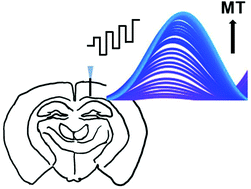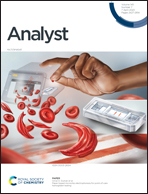Electrochemical detection of exogenously administered melatonin in the brain†
Abstract
Melatonin (MT) is an important electroactive hormone that regulates different physiological actions in the brain, ranging from circadian clock to neurodegeneration. An impressive number of publications have highlighted the effectiveness of MT treatments in different types of sleep and neurological disorders, including Alzheimer's and Parkinson's disease. The ability to detect MT in different regions of the brain would provide further insights into the physiological roles and therapeutic effects of MT. While multiple electrochemical methods have been used to detect MT in biological samples, monitoring MT in the brain of live animals has not been demonstrated. Here, we optimized a square wave voltammetry (SWV) electroanalytical method to evaluate the MT detection performance at CFEs in vitro and in vivo. SWV was able to sensitively detect the MT oxidation peak at 0.7 V, and discriminate MT from most common interferents in vitro. More importantly, using the optimized SWV, CFEs successfully detected and reliably quantified MT concentrations in the visual cortex of anesthetized mice after intraperitoneal injections of different MT doses, offering stable MT signals for up to 40 minutes. To the best of our knowledge, this is the first electrochemical measurement of exogenously administered MT in vivo. This electrochemical MT sensing technique will provide a powerful tool for further understanding MT's action in the brain.

- This article is part of the themed collection: Analytical Science in Neurochemistry


 Please wait while we load your content...
Please wait while we load your content...